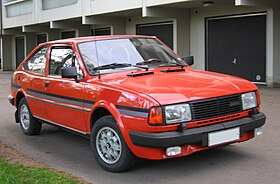Skoda Rapid (1984)
| Škoda Rapid | |
|---|---|
 |
|
| Overview | |
| Manufacturer | AZNP |
| Production | 1984-1990 |
| Assembly | Bratislava |
| Body and chassis | |
| Body style | 2-door coupé |
| Layout | Rear-engine, rear-wheel-drive |
| Related | Škoda 130 |
| Powertrain | |
| Engine | 1174 cc I4 40.5kW (Rapid 120) 1289 cc I4 43kW (Rapid 130, 135) 1289 cc I4 46kW (Rapid 136) |
| Transmission | 4-speed manual (Rapid 120) 5-speed manual (Rapid 130, 135, 136) |
| Dimensions | |
| Wheelbase | 2,400 mm (94 in) |
| Length | 4,200 mm (165 in) |
| Width | 1,610 mm (63 in) |
| Height | 1,380 mm (54 in) |
| Kerb weight | 855–915 kg (1,885–2,017 lb) |
| Chronology | |
| Predecessor | Škoda Garde |
The Škoda Rapid is a fastback coupé designed and built by AZNP in Czechoslovakia between 1984 and 1990. Based on the rear-engined Škoda 130/135/136 sedan, it was a replacement for the Škoda Garde coupe built between 1981 and 1984 itself based upon the Škoda 105/120 sedan design, which was also called the Rapid in the UK market. Some Garde/Rapid cars were sent to Ludgate Design & Development in Kent, United Kingdom, by Škoda to be converted into convertibles.
Although the Škoda sedans had a poor reputation for build quality and handling throughout Western Europe at the time, the Rapid was significant for bucking this trend being described as "the poor man’s Porsche" after defined the Škoda Rapid "a beginners' course to the 911", as it had a rear-mounted engine and rear-wheel drive, just like the Porsche 911.
Today the Škoda Rapid is gaining in popularity as a classic car with Garde and convertible models being most sought after. According to the website "How Many Left?", there were a total of 50 Škoda Rapids left on British roads in 2011.
The Rapid name was originally used on 1930s Škoda models, and was revived again in 2011 on a saloon for the Indian Market, based on the Volkswagen Vento, and in 2012 on a small family car for the international market.
The Rapid, and its predecessor Garde, were internally known as Type 743 models, with the later 135/136 Rapids being referred to as Type 747.
...
Wikipedia
